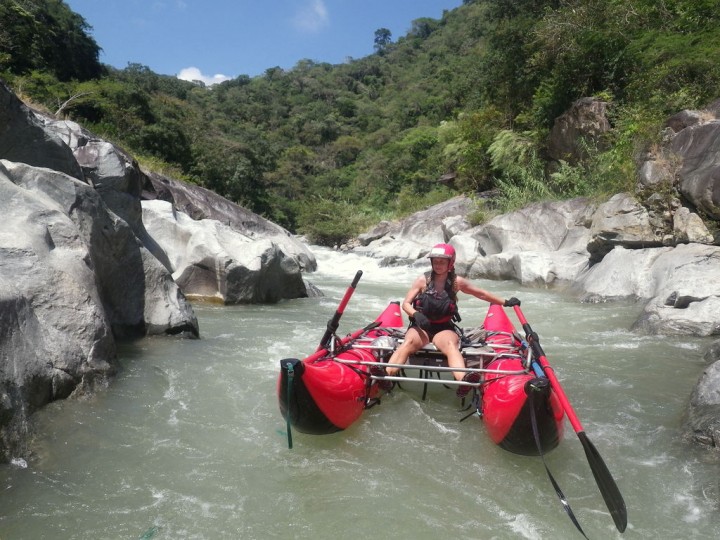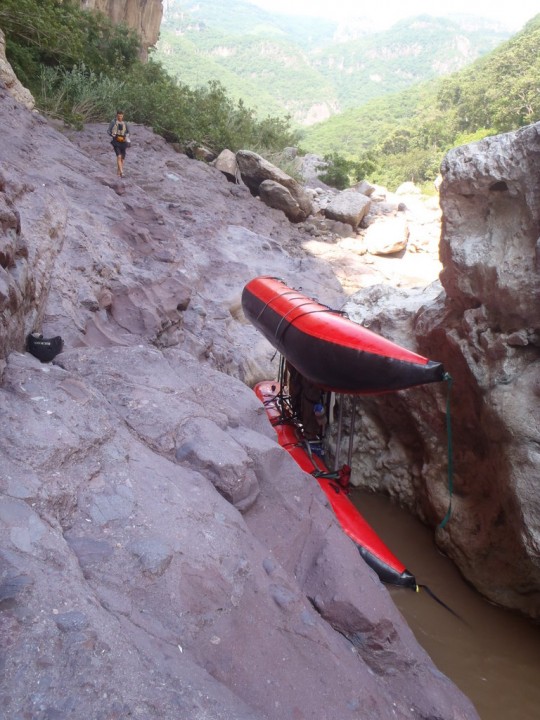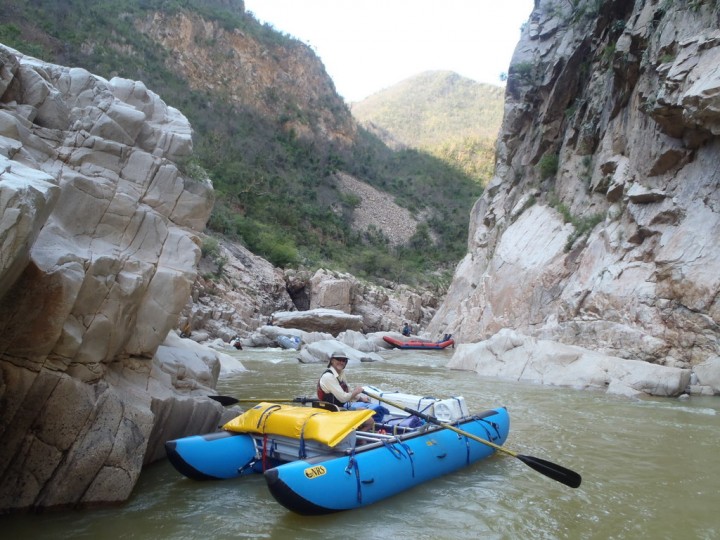Globe-trotting river runner Lacey Anderson shares her love for rafting wild rivers in exotic locations and explains her “go light” philosophy.
It was a hot tropical fall evening in Tlapa de Comonfort, Mexico. I found myself tossing and turning on yet another lumpy Mexican mattress. I was finally slipping into a fitful sleep when I was awakened by the sounds of soft clicking and saw an unearthly blue hue of light reflecting off Rocky’s focused expression. I couldn’t believe it, he was on the computer again! It was two in the morning and he was still staring at that computer! We had spent all day studying maps on that damn machine. Did the man never rest or sleep?
“What are you doing”, I whispered.
“Just double-checking Google Earth, making sure we’re going to take the right road to put-in,” he mumbled.
I thought our route had been determined earlier that evening; I still had a lot to learn about this exploratory river running stuff. I suppose he was right, we should know exactly where we were going, especially since it was only the two of us about to run the first descent of the Rio Tlalixtaquilla (probably Class IV to V). I lay awake for a few more anxious hours wondering if I was worthy of traveling with this pioneering adventurer. Was I really capable of running such difficult rivers? In over twenty years of boating I have learned whitewater lessons from many colorful characters, but I worried the “education” from this expedition might top them all. I lay awake thinking about past people and whitewater lessons learned and attempting to ease my fears, trying to quiet the voice in my head that said I was not skilled enough to hang with this modern-day explorer.

I thought back to my first whitewater teacher, who taught me how to read and run the turbulent waters of class IV and V. Back in the 80s my mentor had the cojones to prove first hand that running the class V Tunnel Chute rapid on the Middle Fork American was possible, and even fun. He introduced me to a badass class V female boater and her river running pals. They did many firsts descents, in paddle boats, on such noteworthy rivers as the Upper Kings and Middle Fork Feather; they understood the power of teamwork! Then there is the fun-loving El Salvadorian who introduced me to the amazing rivers of tropical Mexico. In the late 90s he gathered a group of foot-loose fancy free river guides for training on rivers in the Mexican states of Chiapas and Veracruz. One of my most memorable river trips with him was when we ran the waterfalls of Aqua Azul in paddle rafts!
On a first descent, there are no guidebooks for reference, no one to tell you what to expect around each corner, and no other boaters showing you the lines down the rapids.
In the summer of 2000, more lessons were to be learned through my relationship with another Latino. “Diego” runs horse packing tours and a hotel in Cerocahui, Mexico. He invited me down to help him guide the first commercial river tours on the Rio Urique, deep in the heart of Copper Canyon. Diego packed a gun on those river excursions to defend against drug runners. He opened my eyes to the potential dangers of running rivers in Mexico, even though we never did encounter problems with drug runners. And then there is “Max”, a man I am indebted to for saving my life and the lives of everyone in our group. In the winter of 2012, I was part of an international team of experienced river folk assembled to run the second descent of the Rio Copon in the highlands of Guatemala. To make a long story short, we were held hostage for 24 hours by the local indigenous Mayans. They thought we were associated with mining or hydroelectric interests and put us on trial for the crime of trespassing without getting the proper permission. The Mayan villagers were very angry with us and threatened to kill us by live immolation (tie ‘em up, pour gasoline on ‘em, and burn ‘em!). Due to Max’s careful negotiations, humble attitude, and expertise working with indigenous groups, I am here today to write this story.

As I lay awake remembering lessons learned from these exceptional people, my confidence began to rise; the self-doubting voice in my head was silenced. I remembered my first encounter with Rocky back in the summer of 2010 on the second descent of the Mulatos. I was thrilled to hang out with a new boating friend who could show me the ropes about exploration. I was sure I would learn some valuable lessons from him.
Three years, and many rivers, have passed since our initial meeting, and my rowing skills have improved significantly. How could they not? On a first descent, there are no guidebooks for reference, no one to tell you what to expect around each corner, and no other boaters showing you the lines down the rapids. You simply scout, read and run and learn first hand by having an exciting run. Some are successful and some leave you thinking OMG I can’t believe I screwed up like that! Running first descents has been a thrilling test of my whitewater skills. Not only have my skills improved, but I have developed a basic understanding of how to plan and execute exploratory descents of unknown rivers. People often ask how to prepare for river exploration into the Latin world. I cannot fully describe the process in this short article because in reality what I have learned so far would take an entire book! There is so much that goes into planning an exploratory trip that it cannot be covered in detail here; but I can provide some of the basic information. For me, it boils down to knowledge, equipment, and what I call the “human factor.”

So what are some of the things I do to prepare? Study, study, study…and study some more. What do I study? Maps, all kinds of maps: road maps, geology maps, topographic maps, Google Earth maps, just about every map I can get my hands on. One of the first things is to determine where to access the river and how good the access to and from the river may be. Is it a good paved road, a challenging four wheel drive road, or an intense hike? Then, using a topo map, calculate the gradient (steepness) of the river. I then compare the gradient of the new river to other rivers I know well. Gradient is but one of the factors determining the potential difficulty of rapids. Using the topographic contours and images on Google Earth, I try to determine the nature of the rapids. Will the river likely be pool and drop or continuous? Next, I zoom in on Google Earth as close as possible, looking for waterfalls, boulder-choked channels, narrow canyons, or any spots that may present exceptional challenges. Keep in mind, Google Earth doesn’t show everything—often clouds are in the way, the image is in shadow, or the image quality is poor. The rapids, drops, and obstacles visible on Google Earth will likely be different and potentially much more difficult once we are on the river.
As I study the topo maps and images from Google Earth, I mark important information on the topographical maps I will be carrying on the river. I note such things as the biggest rapids, trouble spots, and roads seen on Google Earth but not shown on the topo map. After this initial research, I may decide a river could be runnable. I then try to figure out what type of rock is in the river channel, as this will influence the characteristics of the rapids and can present some special challenges. For example, limestone is very porous; it is possible for a river to disappear completely into a cave only to reappear half mile later in areas of limestone geology. Granite geology can indicate that rapids are likely to be formed by slabs or large boulders with undercut potential or sieves. I also try to determine when the river may have runnable flows based on hydrologic records, calculated drainage areas, and regional weather patterns. This basic knowledge of the river and region is essential to determine whether or not to attempt an exploratory trip.

Another key to preparation for an exploratory trip is having the appropriate equipment. As equipment and skills have improved over time (remember “bail buckets?”), rafters have been able to run much more difficult river sections than in the past. These days, a few rafters and others (inflatable kayakers, river boarders) are also successfully exploring unknown rivers or sections that were thought to be unrunnable in anything but a kayak. Part of the reason for my success is the combination of equipment and philosophy I have adopted over the years. My equipment is custom built, designed by my husband. He has been playing around with cataraft designs for over twenty five years and perfected the sleek cataraft design I prefer for exploratory river trips. His boat design has performed wonderfully while I have been running the unknown rivers of Mexico. It is small, lightweight, durable, and capable of carrying gear for multiday river trips. I also use a custom made aluminum break-down frame that is very light. I’ve always had a fascination with going as light as possible, so over the last twenty years I’ve developed a kitchen set-up and meals that are healthy yet very lightweight (I do not take coolers or ice). This philosophy has served me very well on exploratory first descents because there have been several occasions where portages were necessary. With my little cataraft and “go light” philosophy, portaging is very doable, not something most traditional rafters could claim.
While it is true that knowledge and equipment are important for successful river adventures, the human element needs to be considered as well. An experienced and cohesive river team is critical. What do I look for in people interested in joining an exploratory trip? People with the skills to safely run difficult rapids and the determination to do whatever it takes to get down the river. People with flexible schedules and the ability to deal with the unexpected, because things happen out there that just can not be planned for. There is always the possibility of a trip taking longer than planned; there can be strenuous portages that end up taking days, or the necessity to walk out of a canyon. Rafting in developing countries is very different than boating in the United States. Participants need to be truly aware of the potential dangers and understand that if an accident happens, there are no helicopters coming quickly to the rescue, no river rangers, and no other boating groups to bail you out.
It is also important to consider the peoples and cultures that live along the river. If we will be boating past isolated indigenous homes, I try to find out if their traditional lifestyle is threatened by mining and hydroelectric projects. If so, they may be unwelcoming and suspicious of outsiders, and the group will need to tread especially lightly with them and be respectful of their lifestyle at all times. Access to the river may even be denied. This “lesson” I learned not from boaters, but from the Mayans who held us hostage and threatened our lives in 2012 (see the Canoe & Kayak article here). I have seen photos of an amazingly beautiful, class IV river with travertine waterfalls in Chiapas, Mexico that I would love to raft, but as of right now the river is off limits to foreigners. The local indigenous population will not grant permission to access that river. After the Guatemala experience, I am not tempted to push my luck!

In 2013 I aim to continue exploring by raft and practicing the lessons learned from boating buddies of the past and present. Travel plans for the rest of 2013 and into 2014 include three months exploring rivers in Mexico, two months assisting with the conservation efforts of a start-up non-profit organization in Guatemala, and then possibly one month rafting in Peru. I hope you can follow along as I continue to write about the adventures of this “River Gypsy”.